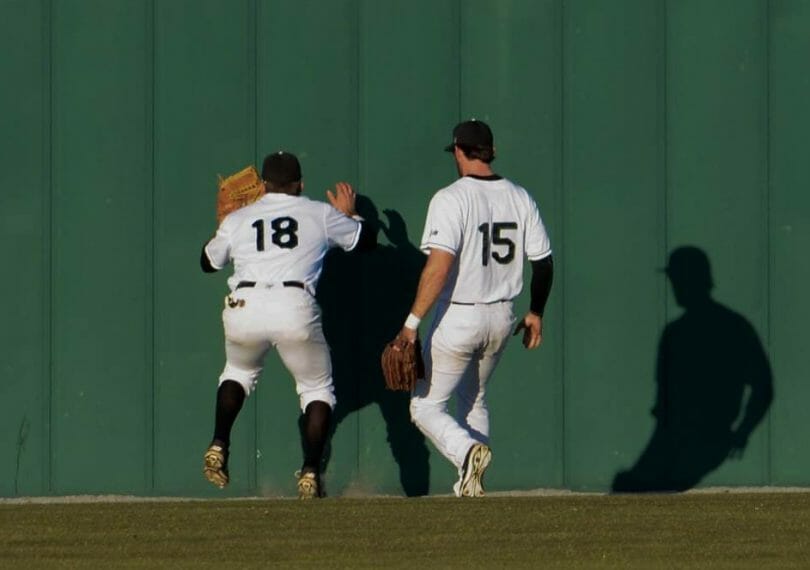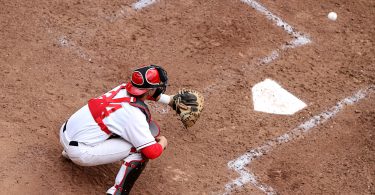The Situation:
It’s a 7-7 ballgame in the top of the 7th inning. There’s a runner on 1st with 1 out, and the left-handed hitting batter has an 0-2 count. The right-handed pitcher gets the sign for a fastball up out of the zone to try to get the batter to chase.
The Play:
The pitcher comes set, checks the runner at 1st and delivers a fastball up above the strike zone. The pitch, which was intended to be up and on the inner half, runs arm-side to the outer edge of the plate. Despite being out of the strike zone, the location allows the lefty to get extended and he surprisingly smashes a line drive to center field. The center fielder charges in hard on the sinking line drive, unsure if he can get there on a dive. The runner at first extends and comes to a stop a little over half-way to second, waiting to see if the center fielder will make the play. At decision time, the center fielder continues full-speed, committed to the dive. He lays out for the ball but comes up about 9 inches short. He misses the ball and it rolls all the way to the wall in center.
The Outcome:
The left fielder, hustling to back-up the play gets to the ball as quickly as he can and throws it to the cutoff man. By the time the ball is back on the infield, the runner from 1st has come around to break the tie and the batter is in at 3rd base with a stand-up triple. Luckily for the center fielder and home team, the pitcher is able to strand the runner at 3rdwith back-to-back outs and limit the damage to one run. Regardless, the home team heads to the bottom of the 7th trailing by 1.
What Went Wrong:
This is a split second decision by the outfielder, who must read the ball and determine if diving is worth the risk. It’s worth noting that as an outfielder, these decisions and your aggressiveness to the ball can be greatly assisted by thinking the game before the batter comes to the plate to make sure you have a full understanding of the situation and the risks and rewards of playing aggressively. In this case, the center fielder makes a poor decision to dive, even though only 9 inches separate him from being a hero. Rather than simply criticize the decision, which was incredibly difficult, let’s explain why it was wrong, regardless of outcome.
- The situation: With a runner at 1st and 1 out, pulling up on the ball doesn’t cost a run and keeps the double play in order. Sure, you would like to get the out, but the risks (the lead and giving up the double play position) are not worth the reward. The offense will still have to earn the run with a hit or multiple free passes, and you want to hold them to the bases they deserve and make them earn every run.
- The ball’s trajectory (flight): On fly balls with more loft, the ball will not roll as far on a missed dive. In many cases, going for the dive on a higher fly ball means risking 1 extra base for the offense, rather than several. The outfielder should know the way the field plays and have an idea of what type of fly balls he can dive for before the ball is even hit. On a line drive that will roll and roll, you must be 100% sure that you will keep the ball in front of you if you dive. He wasn’t 100% sure and he paid for it. Here is an example of a ball trajectory that regardless of whether the outfielder whiffs on the ball will remain close.
- No Backup: When an outfielder is going back on a ball and has backup from the outfield wall, it is often better to dive because the ball will only roll a little ways and not diving likely means the ball will get by the outfielder anyways. Here is a good Major League example of this type of play. Dive or no dive, the ball is going to get by the outfielder. Not only does he have backup from the fence close by, but from the other outfielder as well. If backup is close and it will limit the risks of missing the ball, it’s more acceptable to dive for the ball, even in a situation like the one described above.
- Certainty: While numbers 1-3 above are things that can be thought through before the play, every outfielder will have an inner level of certainty as they go after a ball. Considering 1-3 on this particular play, that certainty level must be at or around 100% to justify the risk in this situation.
Because of these four reasons, the dive by the outfielder is ill-advised and leaves him susceptible to what happens. Watch the actual clip of this play for yourself here and remember to always think the game before the ball is put in play.







